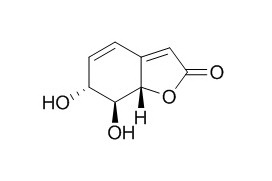Griffonilide
Griffonilide is islolated from the tubers of Tylosema esculentum (morama).
Inquire / Order:
manager@chemfaces.com
Technical Inquiries:
service@chemfaces.com
Tel:
+86-27-84237783
Fax:
+86-27-84254680
Address:
1 Building, No. 83, CheCheng Rd., Wuhan Economic and Technological Development Zone, Wuhan, Hubei 430056, PRC
Providing storage is as stated on the product vial and the vial is kept tightly sealed, the product can be stored for up to
24 months(2-8C).
Wherever possible, you should prepare and use solutions on the same day. However, if you need to make up stock solutions in advance, we recommend that you store the solution as aliquots in tightly sealed vials at -20C. Generally, these will be useable for up to two weeks. Before use, and prior to opening the vial we recommend that you allow your product to equilibrate to room temperature for at least 1 hour.
Need more advice on solubility, usage and handling? Please email to: service@chemfaces.com
The packaging of the product may have turned upside down during transportation, resulting in the natural compounds adhering to the neck or cap of the vial. take the vial out of its packaging and gently shake to let the compounds fall to the bottom of the vial. for liquid products, centrifuge at 200-500 RPM to gather the liquid at the bottom of the vial. try to avoid loss or contamination during handling.
J Ethnopharmacol.2017, 196:75-83
Microbiol. Biotechnol. Lett.2022, 50(2): 193-201.
Hong Kong Baptist University2023, 048330T.
GxABT2022, 2268.2:15515.
Int J Mol Sci.2022, 23(11):6172.
Natural Product Communications2023, 18(9).
J Microbiol Biotechnol.2024, 35:e2408022.
J Ethnopharmacol.2022, 282:114574.
Plant Physiol.2024, 194(4):2580-2599.
Bioorg Chem.2024, 145:107184.
Related and Featured Products
Phytother Res. 2015 Jul 21.
Therapeutic and Prophylactic Potential of Morama (Tylosema esculentum): A Review.[Pubmed:
26206567]
Tylosema esculentum (morama) is a highly valued traditional food and source of medicine for the San and other indigenous populations that inhabit the arid to semi-arid parts of Southern Africa.
METHODS AND RESULTS:
Morama beans are a rich source of phenolic acids, flavonoids, certain fatty acids, non-essential amino acids, certain phytosterols, tannins and minerals. The plant's tuber contains Griffonilide, behenic acid and starch. Concoctions of extracts from morama bean, tuber and other local plants are frequently used to treat diarrhoea and digestive disorders by the San and other indigenous populations. Information on composition and bioactivity of phytochemical components of T. esculentum suggests that the polyphenol-rich extracts of the bean testae and cotyledons have great potential as sources of chemicals that inhibit infectious microorganisms (viral, bacterial and fungal, including drug-resistant strains), offer protection against certain non-communicable diseases and promote wound healing and gut health. The potential antinutritional properties of a few morama components are also highlighted.
CONCLUSIONS:
More research is necessary to reveal the full prophylactic and therapeutic potential of the plant against diseases of the current century. Research on domestication and conservation of the plant offers new hope for sustainable utilisation of the plant.
Bioorg Med Chem. 2011 Sep 1;19(17):5225-30.
Tylosema esculentum extractives and their bioactivity.[Pubmed:
21813280]
METHODS AND RESULTS:
The investigation of Tylosema esculentum (Morama) husks, cotyledons, and tuber yielded Griffonilide 2, compound 1, griffonin 3, gallic acid 4, protocatechuic acid 5, β-sitosterol 6, behenic acid 7, oleic acid 8, sucrose 9, 2-O-ethyl-α-D-glucopyranoside 10, kaempferol 11 and kaempferol-3-O-β-D-glucopyranoside 12. The structures of the isolates were determined by NMR, HR-TOF EIMS, IR and UV-vis spectroscopy, and by comparison with literature data. The husk EtOAc and n-butanol extracts demonstrated >90% DPPH radical scavenging activity at concentrations of 25, 50 and 250 μg/mL. Furthermore the husk extracts showed higher total phenolic content (233 mg GAE/g). The extractives exhibited minimum inhibitory quantities of 50-100 μg or no activity against Staphylococcus aureus, Escherichia coli, Bacillus subtilis, Pseudomonas aeruginosa and Candida albicans. The tuber extracts were inactive against Caco-2 and Hela cell lines, while the husk extracts showed low activity against Caco-2 and Vero cell line with IC(50) values >400 μg/mL.
CONCLUSIONS:
The GC-MS analysis showed the beans and tuber non-polar (n-hexane) extracts major constituents as fatty acids.



